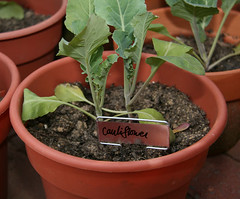Organic gardening isn’t only for farmers or people who have backyards - it can also be done using containers.
Organic vegetable gardening containers have advantages. You can use your garden as décor on your balcony or patio. If the weather gets too cold outside, you can bring it indoors. But best of all, you don’t have to deal with certain threats that can happen outdoors like weeds, insects or soil borne diseases.
 Image via Wikipedia
Image via WikipediaOrganic vegetable gardening containers typically do not use soil. You need to use
potting mix
that is much lighter and provides excellent drainage. You'll also need to use organic fertilizer though to help it grow, such as mulch that can be made from chipped bark, garden compost, leaf moulds and manure. Not only does this fertilize your garden, but it also helps keep it from drying out.
Another thing your container plants will need is a lot of water. Ideally, you should add this in small amounts at least 30 minutes after an initial watering because putting in too much could drown your plant. If the container that you purchased does not have any holes in the bottom, make a few before adding your growing matter and planting.
The containers can either be hung from a railing or overhang, or set on the ground, depending on their size and what you will be planting in them.
You may be asking, “What are the ideal vegetables to be planted in these containers?” Lots of veggies do well in containers, but to give you an idea, some good choices are bush beans, peppers, carrots, eggplant, lettuce, onions, peas, radishes, spinach, strawberries, and tomatoes. (Potatoes can also do well, though there are some special considerations to growing them this way.)
You know that organically grown vegetables need sunlight, so they do best with some outside exposure. If you have a lot of these containers and it is very windy outside, you can protect them from falling by grouping these together with the taller ones as your "walls".
 Image via Wikipedia
Image via WikipediaThe best organic vegetable gardening containers are those made from clay, plastic or wood. The length of the roots and its width is the deciding factor when choosing what size container you will buy. For instance, if your vegetable happens to have 6 inches of roots and grows to about 10 inches wide, it is best to get a container that measures 8 inches deep and 10 to 12 inches wide. (You should always give room for allowance as some may grow bigger than it says on the container or seed package.)
We mentioned earlier that one of the advantages of the organic container garden is that you don’t have to deal with insects. But sometimes, bugs like the hookworm manage to get to your plant. If this happens, just bring the container to the sink (or hose) and wash the leaves. Should there be slugs, get rid of them by sprinkling
diatomaceous earth
on the soil.
If there are aphids on your vegetables, fight fire with fire by getting other insects to do the dirty work. A pack of
ladybugs
will do the trick without causing any collateral damage.
Organic vegetable container container gardening makes it possible for those without a backyard to have the chance to plant their own crops at home. This is ideal for residents living in condos and apartments so they can save money to pay for rent or buy other things when the sustenance they need is just sitting by the balcony or window.
If you want to try it, go ahead and ask someone at the gardening store for some help to get you started. Or check out
http://www.newholisticliving.com/sustainablegardening.html, or some of the helpful resources below.
Organic Container Gardening Resources:







